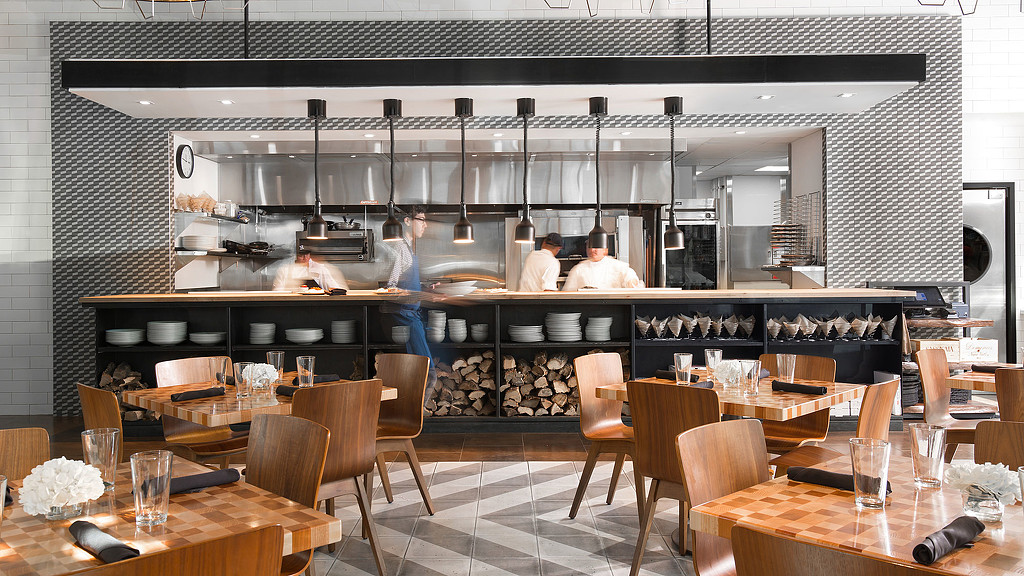The Future of Dining Out
May 14, 2020 | By Siobhan Barry
Editor’s Note: This post is part of our ongoing exploration of how design is responding to the COVID-19 pandemic.
The current health crisis has hit the restaurant industry harder than nearly any other sector. As many as 20% of all U.S. restaurants could close permanently because of the coronavirus pandemic, according to UBS. In some hard-hit markets, like New York, that the number could be as high as 50%, according to some estimates.
Beyond this devastating economic impact, the pandemic has also taken a toll on our social and personal well-being. The habit of breaking bread with one another has been a communal activity as long as we have existed. The shelter-in-place orders enacted to curb the spread of COVID-19 have prohibited this once vibrant and meaningful event from taking place outside the home. Once we’re able to gather in larger groups again, we’ll all be looking for the connection, community, and joy that comes from eating together.
We’ll eventually get back to old habits, but when, where, and how we’ll be able to dine out is going to change. What’s it going to take for people to feel safe and comfortable to sit down and break bread with one another again?
In the same way that diners expect to know where their food is sourced, they’ll want the same level of transparency about how restaurant owners are keeping their venues clean. How else will they feel comfortable coming back into dining rooms and bars again?
In response, proprietors with the means and ability to pivot toward near-term needs will diversify their service and business models to stay afloat. In restarting operations, there are several factors to consider when calibrating business and planning models. Will delivery/take-out become a larger share of revenue than on-site dining? How do you curate the take-out experience to support the brand or culinary approach? Does the density and seat count go down temporarily in both dining rooms and bars? Will communal tables go away?
Here are six considerations for restaurant and bar owners in an era of new consumer expectations.
1. Cleanliness is paramount to gaining customers’ trust.As food and beverage establishments reopen, visual cues conveying that cleanliness is a top priority will be critical to establish trust with consumers. White glove service, marked by special care or attention to cleaning and sanitization, may become the norm for servers. Diners may witness a form of “cleanliness theater” — a celebration of the actual act of cleaning the space.
2. Space will be the new luxury.Intimate dining will change. In the near future, there will be no more sitting shoulder-to-shoulder with other diners. During this time, seat count may be reduced in bars and dining rooms to accommodate physical distancing guidelines. Fine dining will be reinvented — perhaps becoming even more expensive and exclusive for customers who will pay a premium for the luxury of fewer tables with larger spaces in between.
3. Traditional back-of-house functions could move forward.The trend of open kitchens will become more prevalent, as more diners express a desire to see their food being made. Consumers might turn to quick-service restaurants, where they can see their food prepped and cooked in person.
4. Health regulations will change — we just don’t know how yet.Masks and gloves will be the norm in the kitchen and possibly the dining area. Restaurant and bar owners will need to keep apprised of changing health and safety regulations. Food surfaces will need to be regularly sanitized, and buffets will feature either wrapped food for guests to hand-select or an employee-assisted servery. Some establishments may scan customers’ temperatures before they can enter.
5. Touchless payment, service, and delivery will gain popularity.Self-service models, already being developed, could become increasingly popular. Much like in retail, frictionless or touchless ordering and payment methods such as Apple Pay or Google Wallet will become preferred. Curbside pickup and delivery are also likely here to stay.
6. Ghost kitchens might offer a path to survival.Ghost kitchens have become a go-to operational strategy as a response to rising food and rent costs and the proliferation of food-delivery platforms like Grubhub and Seamless. Many home delivery meals come straight from a ghost kitchen, a professional food preparation and cooking facility set up for delivery-only meals. Repositioning a restaurant to a ghost kitchen is one way to maintain an income stream, keep valuable staff employed, and build trust with customers. This entry point could establish a brand and usher in the eventual conversion from delivery to dine-in.
Restaurateurs who are sensitive to customer concerns, earn their trust, and provide a thoughtful and comprehensive end-to-end experience will succeed in this new normal. Reentry strategies will likely be regional. Restaurateurs in New York, for example, are going to have a different journey than those in markets hit less hard by COVID-19.
While the path to reopening is uncertain, we have an opportunity to reinvent how we eat, drink, and gather. The design industry will need to innovate with forward-thinking solutions in planning, design, brand, and packaging to help our clients rethink their on-site dining services in the near term, and look ahead at resilient business strategies for the “future normal.”
For any media inquiries, please email .

